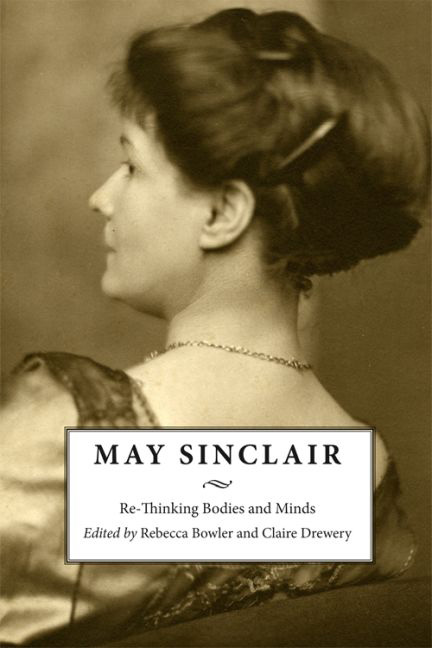Book contents
- Frontmatter
- Contents
- Acknowledgements
- Introduction: May Sinclair's Interdisciplinarity
- Part I The Abstract Intellect
- Part II Abject Bodies
- 6 Disembodying Desire: Ontological Fantasy, Libidinal Anxiety and the Erotics of Renunciation in May Sinclair
- 7 May Sinclair and Physical Culture: Fit Greeks and Flabby Victorians
- 8 Dolls and Dead Babies: Victorian Motherhood in May Sinclair's Life and Death of Harriett Frean
- 9 Why British Society Had to ‘Get a Young Virgin Sacrificed:’ Sacrificial Destiny in The Tree of Heaven
- 10 ‘Odd How the War Changes Us’: May Sinclair and Women's War Work
- 11 Transgressing Boundaries; Transcending Bodies: Sublimation and the Abject Corpus in Uncanny Stories and Tales Told by Simpson
- Notes on Contributors
- Index
7 - May Sinclair and Physical Culture: Fit Greeks and Flabby Victorians
from Part II - Abject Bodies
Published online by Cambridge University Press: 26 May 2017
- Frontmatter
- Contents
- Acknowledgements
- Introduction: May Sinclair's Interdisciplinarity
- Part I The Abstract Intellect
- Part II Abject Bodies
- 6 Disembodying Desire: Ontological Fantasy, Libidinal Anxiety and the Erotics of Renunciation in May Sinclair
- 7 May Sinclair and Physical Culture: Fit Greeks and Flabby Victorians
- 8 Dolls and Dead Babies: Victorian Motherhood in May Sinclair's Life and Death of Harriett Frean
- 9 Why British Society Had to ‘Get a Young Virgin Sacrificed:’ Sacrificial Destiny in The Tree of Heaven
- 10 ‘Odd How the War Changes Us’: May Sinclair and Women's War Work
- 11 Transgressing Boundaries; Transcending Bodies: Sublimation and the Abject Corpus in Uncanny Stories and Tales Told by Simpson
- Notes on Contributors
- Index
Summary
Mary Olivier, the work which most critics claim marks the transition between the fin-de-siècle novels of the young May Sinclair and her later modernist efforts, is a novel about activity overcoming lethargy. Mary Olivier is in thrall to her mother, who wishes her to stay at home, to sew and to become a ladylike and passive young lady. Mary, however, is an intellectual. She is in love with the process of learning as adventure, and she is also in love with the athletic and dynamic power of her own body, a body which ‘could excite itself with its own activity and strength’ (Sinclair 1919: 226). Mary's dilemma is that the passive domesticity that her mother wants for her, and the life of intellectual adventure that she wants for herself, are both antithetical to an active life. As her brother Mark warns her, ‘“if you stodge like that you'l get all flabby”’ (Sinclair 1919: 84). In Mary's quest to become a modern woman and to shake off her mother, her very own ‘Angel of the House’, she must find and embrace both athleticism and intellectualism; she must figuratively and literally escape the boundaries of the home and stretch her legs in the public world. This emphasis on freedom and activity is a part of what makes Mary Olivier so modern.
However, Sinclair had explored these themes in a much earlier work. The Combined Maze, published in 1913, is an allegory about two possible futures for the human race. One possible future is to continue along Victorian lines, with working men and women either ‘weedy, parched, furtively inebriate’ like the hero Ranny's father, or with the ‘flabbiness’ of his father's chemist assistant, Mercier (Sinclair 1913: 1; 24). The alternative is for young people to throw off their Victorian shackles, to stride forth into the world, to run and jump, and to establish their lives upon the principles of moral and physical fitness.
The hero of The Combined Maze, ‘John Randall Fulleymore Ransome, and Ranny for short’ (Sinclair 1913: 1), is not just an athlete, but a clerk, whose work is abhorrent to him; he works so that he can live, and so that, in the evenings, he can go to the Polytechnic Gym and absorb himself in the ‘fusion of all faculties in one rhythm and one vibration, one continuous transport of physical energy’ (Sinclair 1913: 23).
- Type
- Chapter
- Information
- May SinclairRe-Thinking Bodies and Minds, pp. 139 - 155Publisher: Edinburgh University PressPrint publication year: 2017



